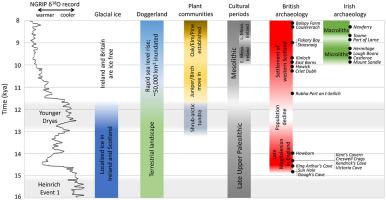当前位置:
X-MOL 学术
›
Quat. Sci. Rev.
›
论文详情
Our official English website, www.x-mol.net, welcomes your
feedback! (Note: you will need to create a separate account there.)
The colonization of Ireland: A human ecology perspective
Quaternary Science Reviews ( IF 3.2 ) Pub Date : 2020-12-01 , DOI: 10.1016/j.quascirev.2020.106632 Jesse W. Tune
Quaternary Science Reviews ( IF 3.2 ) Pub Date : 2020-12-01 , DOI: 10.1016/j.quascirev.2020.106632 Jesse W. Tune

|
Abstract Human migration throughout northern Europe following the Last Glacial Maximum is an ideal situation to investigate human colonization and adaptation in new landscapes. This is particularly so in Ireland, which possesses a distinctly compressed archaeological record compared to the rest of Europe. While various periods of Paleolithic occupations are well-documented throughout Europe, including Britain, the initial colonization of Ireland appears to be delayed until the Early Holocene. An assessment of archaeological and paleoenvironmental data suggests that inhospitable environmental conditions, specifically the absence of mature woodland ecosystems, substantially delayed the human colonization of Ireland. Once Mesolithic peoples reached Ireland, the absence of familiar fauna led them to quickly modify existing technologies. These local adaptions are reflected in the discontinuation of composite microlith technologies that characterize the rest of the European Mesolithic record. Within 1000 years of colonization, Mesolithic hunter-gatherers developed a uniquely Irish macrolith-based technology.
中文翻译:

爱尔兰的殖民化:人类生态学的视角
摘要 在末次盛冰期之后整个北欧的人类迁徙是研究人类在新景观中的殖民和适应的理想情况。在爱尔兰尤其如此,与欧洲其他地区相比,爱尔兰的考古记录明显压缩。虽然旧石器时代的各个时期的占领在整个欧洲(包括英国)都有详细记录,但爱尔兰的最初殖民化似乎被推迟到全新世早期。对考古和古环境数据的评估表明,恶劣的环境条件,特别是缺乏成熟的林地生态系统,大大推迟了人类在爱尔兰的殖民。中石器时代的人们到达爱尔兰后,由于缺乏熟悉的动物群,他们迅速修改了现有技术。这些局部适应反映在复合微石技术的停止,这些技术是欧洲中石器时代其他记录的特征。在殖民化的 1000 年内,中石器时代的狩猎采集者开发了一种独特的爱尔兰巨石技术。
更新日期:2020-12-01
中文翻译:

爱尔兰的殖民化:人类生态学的视角
摘要 在末次盛冰期之后整个北欧的人类迁徙是研究人类在新景观中的殖民和适应的理想情况。在爱尔兰尤其如此,与欧洲其他地区相比,爱尔兰的考古记录明显压缩。虽然旧石器时代的各个时期的占领在整个欧洲(包括英国)都有详细记录,但爱尔兰的最初殖民化似乎被推迟到全新世早期。对考古和古环境数据的评估表明,恶劣的环境条件,特别是缺乏成熟的林地生态系统,大大推迟了人类在爱尔兰的殖民。中石器时代的人们到达爱尔兰后,由于缺乏熟悉的动物群,他们迅速修改了现有技术。这些局部适应反映在复合微石技术的停止,这些技术是欧洲中石器时代其他记录的特征。在殖民化的 1000 年内,中石器时代的狩猎采集者开发了一种独特的爱尔兰巨石技术。











































 京公网安备 11010802027423号
京公网安备 11010802027423号